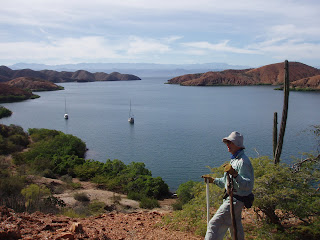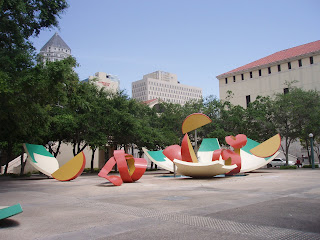Venezuelan Red Tape
Venezuelan bureaucracy is not for the faint hearted.
Our latest encounter with government regulations began several days ago with a surprise "raid." More than a dozen red shirted officials from the government tax and customs agency descended on our marina. They proceeded to attach large stickers to every non- Venezuelan boat which meant those boats were impounded or seized until Customs decided otherwise. Apparently there has been a problem in this country of people buying boats/yachts in the U.S. and elsewhere, then bringing them to Venezuela under that foreign flag thereby evading customs tax.

To prove we were legitimate non- Venezuelan owners of our boat, all the boaters staying in this and other marinas were required to make an appearance at the main Customs office in another town with our necessary documents: boat registration, passports, etc. It would seem to have been a simple matter for the officials who put stickers on everyone's boat to just ask to see our papers and settle any questions on the spot. But that's not how things are done in Venezuela, where officials like to show their power by making things difficult for you and at the same time creating more paperwork for their already slow-moving department.

A few days later a busload of us foreign boaters was shuttled from our marina to the Customs office. The marina, Bahia Redonda, provided the free bus ride and arranged for us to be accompanied by independent agents who know the customs procedures. Marina management wants to minimize these kinds of government intrusion so that boaters will not become disenchanted with Venezuela and sail elsewhere in the Caribbean.

Soon we arrived at the gleaming new office complex that is the area head- quarters for Venezuelan customs and taxation, known here as SENIAT, Servicio Nacional Integrado de Adminis- tración Aduanera y Tributaria.
We've noticed here that shiny new buildings and modern offices do not guarantee efficient or even minimal service. Even with experienced agents representing us, there followed a two hour wait when everyone tried to find out what we were supposed to do. The Customs people did not really know what our document inspection was all about. There was even talk of a new tax being levied at the rate of 1% of the value of each boat.

Finally we were called together and everyone's papers were collected, although not the same documents we had previously been told were required. This meant leaving our precious passports and original ownership documents in the hands of unknown clerks and an unpredictable bureaucracy. It made us all nervous but we had no choice if we wanted to comply with this vague new regulation. Then we were told to return to the marina and wait to be notified, of what...we weren't sure.
Sending us away seemed a strange thing to do since we understood that the main purpose of going to the customs office was to verify everyone's identity in person by matching faces with passports and other documents. But who were we to question? So it was time for everyone to leave the customs office, but, surprise, our bus had gone missing. Now we waited some more while our chaperones made urgent cell phone calls trying to locate the bus and order it back to us. Finally the wayward vehicle was found and we were all returned to our boats at the marina to await further developments.

The next day we were summoned to our agent's office at the marina for the latest twist. Customs now wanted an arrival-in-country document which they had previously not cared about. This kind of unexplained reversal of procedure happened often, as when we were first told that only original documents were acceptable. Then it was fine to submit just copies, but wait, no, never mind, they want originals after all. You could not escape the impression that these government officials were making it up as they went along.
Another newly minted rule that applied to us was that only five boats would be processed per day. There were over 50 boats waiting for processing just in our marina alone, some needing their paperwork urgently so they could leave the country. Since the paperwork inspection for one boat could surely take no more than 15 minutes, the 5-a-day rule also seemed arbitrary, an ad-hoc way to ensure that Customs officials would not be overworked by this sudden influx of strenuous document shuffling.

Two days later our ship's papers were returned to us safely, but we still needed the official document making us legal and giving permission to peel the impound sticker off our boat. This was no small matter since a boat at another marina that tried to sail a short distance without this document was stopped by Venezuelan troops with machine guns. One of the worst things about bumbling, unprofessional bureaucracies in other countries, and ours too sometimes, is their eagerness to enforce rules that are haphazard or even incomprehensible. Anyone who objects or has had enough of their nonsense may be looking at fines, jailtime or down the barrel of a soldier's gun. A frustrating experience like this helps you appreciate well-run government operations when you see them.
The following day we did receive our Acta de Liberacion, allowing us to go back to life as usual before this latest fit of craziness began. We shouldn't complain much since we had many good people helping to resolve these problems and the whole business lasted only one week. And it could have been worse, as it is for people around the world stuck in bureaucratic nightmares with a lot at stake. What we went through concerning our boat, which is our home, was enough for us, thank you. We don't recommend it, so keep your papers in order and hope for the best.




















































